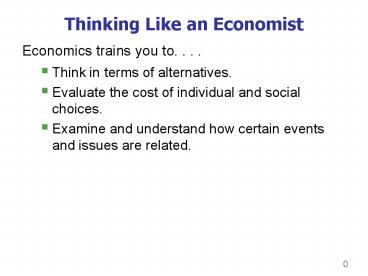Thinking Like an Economist - PowerPoint PPT Presentation
1 / 19
Title:
Thinking Like an Economist
Description:
Buy and consume goods and services. Own and sell factors of production ... Cars Produced. 2,200. 600. 2,300. 650. 0. 4,000. 3,000. 1,000. Quantity of. Computers ... – PowerPoint PPT presentation
Number of Views:37
Avg rating:3.0/5.0
Title: Thinking Like an Economist
1
Thinking Like an Economist
- Economics trains you to. . . .
- Think in terms of alternatives.
- Evaluate the cost of individual and social
choices. - Examine and understand how certain events and
issues are related.
2
THE ECONOMIST
- The economist has two roles he/she can play
- The economist as a scientist tries to explain the
world. - The economist as a policy adviser tries to change
the world.
3
The Economist as a Scientist
- thinks analytically and objectively.
- Makes use of the scientific method.
- Uses abstract models to help explain how a
complex, real world operates. - Develops theories, collects and analyzes data to
evaluate the theories.
4
The Role of Assumptions and Models
- Economists make assumptions in order to make the
world easier to understand. - They make appropriate assumptions and build
simplified models in order to understand the
world around them. - Economists use models to simplify reality in
order to improve our understanding of the world.
5
Economic Models
- Two of the most basic economic models are
- The Circular Flow Diagram
- The Production Possibilities Frontier
- The circular-flow diagram is a visual model of
the economy that shows how dollars flow through
markets among households and firms.
6
Figure 1 The Circular Flow
Spending
Revenue
Income
Flow of inputs
and outputs
Flow of dollars
7
Our First Model The Circular-Flow Diagram
- Assumptions
- Only 2 decision makers in the economy (firms and
households). - Only two markets (markets for factors of
production and markets for goods and services).
8
The Circular-Flow Diagram
- Firms
- Produce and sell goods and services
- Hire and use factors of production
- Households
- Buy and consume goods and services
- Own and sell factors of production
9
Our First Model The Circular-Flow Diagram
- Markets for Goods and Services
- Firms sell
- Households buy
- Markets for Factors of Production
- Households sell
- Firms buy
- Factors of Production are inputs used to produce
goods and services such as Land, labor, and
capital
10
Our Second Model The Production Possibilities
Frontier
- The production possibilities frontier is a graph
that shows the combinations of output that the
economy can possibly produce given the available
factors of production and the available
production technology.
11
Figure 2 The Production Possibilities Frontier
Quantity of
Computers
Produced
3,000
Quantity of
0
1,000
Cars Produced
12
Our Second Model The Production Possibilities
Frontier
- Concepts illustrated by the production
possibilities frontier - Efficiency
- Trade-offs
- Opportunity cost
13
Figure 3 A Shift in the Production Possibilities
Frontier
Quantity of
Computers
Produced
Quantity of
0
Cars Produced
14
The Economist as Policy Adviser
- When economists are trying to explain the world,
they are scientists. - When economists are trying to change the world,
they are policy advisors.
15
Positive versus Normative Analysis
- Positive statements are statements that attempt
to describe the world as it is. - Called descriptive analysis
- Normative statements are statements about how the
world should be. - Called prescriptive analysis
- When economists make normative statements, they
are acting more as policy advisors than
scientists.
16
Positive Versus Normative Analysis
- Higher federal budget deficits will cause
interest rates to increase. - POSITIVE STATEMENT
- The governments should lower taxes in order to
stimulate spending. - NORMATIVE STATEMENT
17
Economists in Washington
- Economists serve as advisers in the policymaking
process of the three branches of government - Legislative
- Executive
- Judicial
18
Economists in Washington
- Some government agencies that collect economic
data and make economic policy include - Department of Commerce
- http//www.commerce.gov
- Bureau of Labor Statistics
- http//www.bls.gov
- Congressional Budget Office
- http//www.cbo.gov
- Federal Reserve Board
- http//www.federalreserve.gov
19
WHY ECONOMISTS DISAGREE
- They may disagree about the validity of
alternative positive theories about how the world
works. - They may have different values and, therefore,
different normative views about what policy
should try to accomplish.






























